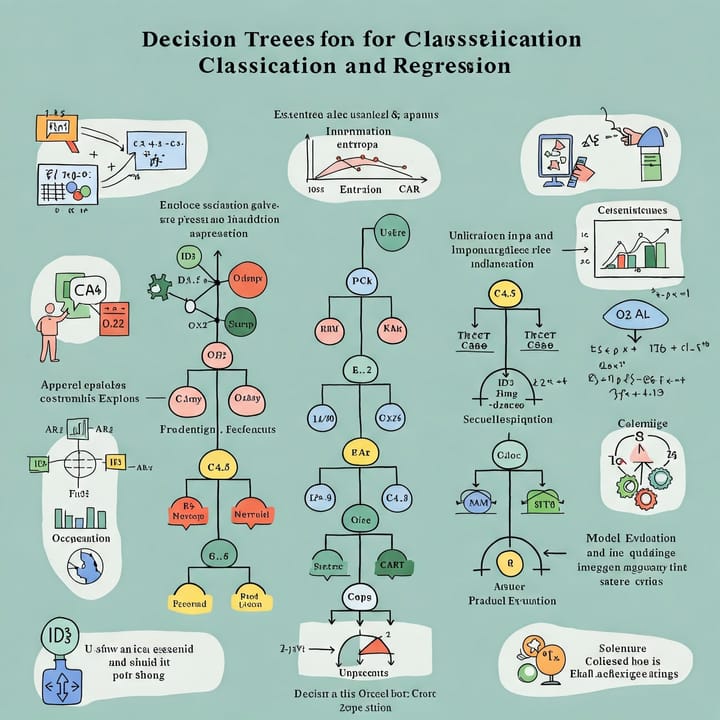Overfitting and Underfitting: How to Identify and Address Them
In machine learning, the goal is to build models that accurately predict outcomes on new, unseen data. Two common problems that hinder this goal are overfitting and underfitting. These issues arise from a mismatch between the model's complexity and the complexity of the underlying data patterns. This article explains what overfitting and underfitting are, how to identify them, and provides practical strategies to address them, with references to relevant research and resources.
1. What is Overfitting?
Overfitting occurs when a model learns the training data too well, including its noise, random fluctuations, and irrelevant details. The model essentially "memorizes" the training data rather than learning the general underlying patterns. As a result, it performs very well on the training data but poorly on new, unseen data (validation and test sets). The model has high variance and low bias.
Analogy: Imagine a student who memorizes all the answers to the practice questions for an exam but doesn't actually understand the underlying concepts. They'll ace the practice test but fail the real exam because they can't apply their knowledge to new problems.
Characteristics of an Overfitting Model:
- Low training error: The model performs very well on the training data.
- High validation/test error: The model performs significantly worse on unseen data.
- Large gap between training and validation/test error: This is a key indicator.
- Complex model: Overfitting is more common with complex models (e.g., deep neural networks, high-degree polynomials) that have many parameters.
- Sensitivity to noise: The model is highly sensitive to small variations in the training data.
2. What is Underfitting?
Underfitting occurs when a model is too simple to capture the underlying patterns in the data. It fails to learn the relationships between the input features and the target variable adequately. As a result, it performs poorly on both the training data and new data. The model has high bias and low variance.
Analogy: Imagine trying to fit a straight line to data that clearly follows a curved path. The linear model is too simplistic to capture the true relationship.
Characteristics of an Underfitting Model:
- High training error: The model performs poorly even on the training data.
- High validation/test error: The model also performs poorly on unseen data.
- Training and validation/test errors are similar (and high): This indicates that the model is not learning the underlying patterns.
- Simple model: Underfitting is more common with simple models (e.g., linear regression applied to non-linear data).
3. Identifying Overfitting and Underfitting
The primary way to identify overfitting and underfitting is by comparing the model's performance on the training set and a separate validation set (or using cross-validation).
- Learning Curves: Plotting learning curves is a powerful diagnostic tool. Learning curves show the model's performance (e.g., error or accuracy) on both the training and validation sets as a function of the training set size or the number of training iterations.
- Overfitting: The training error will be very low, and the validation error will be significantly higher and may plateau or even increase as training progresses. There's a large gap between the two curves.
- Underfitting: Both the training error and the validation error will be high, and they will be relatively close to each other. The curves may plateau quickly, indicating that the model is not learning.
- Good Fit: Both the training error and the validation error will decrease and converge to a low value. The gap between the curves will be small.
- Regularization Paths: For models with regularization (e.g., L1 or L2 regularization), you can plot the model's coefficients as a function of the regularization strength. Overfitting models tend to have very large coefficients, which will shrink towards zero as regularization strength increases.
- Model Complexity Analysis: Intuitively, if your model is extremely complex (many parameters) relative to the amount of data you have, it's more prone to overfitting. Conversely, a very simple model might underfit.
4. Addressing Overfitting
Several techniques can be used to combat overfitting:
- 1. Get More Data: This is often the most effective solution. A larger training dataset makes it harder for the model to memorize the noise and forces it to learn the underlying patterns. [1, 6]
- 2. Data Augmentation: Create synthetic data points from your existing data by applying transformations (e.g., rotations, flips, crops for images; adding noise, paraphrasing for text). This effectively increases the size of your training set. [7]
- 3. Feature Selection: Remove irrelevant or redundant features. This reduces the model's complexity and makes it less prone to overfitting. Techniques include:
- Univariate Feature Selection: Select features based on statistical tests (e.g., chi-squared, ANOVA).
- Recursive Feature Elimination (RFE): Recursively remove features and evaluate model performance.
- Feature Importance from Tree-Based Models: Use feature importance scores from models like Random Forests or Gradient Boosting Machines.
- 4. Regularization: Add a penalty term to the loss function that discourages large model coefficients. This encourages the model to be simpler and less prone to overfitting. Common types include:
- L1 Regularization (Lasso): Adds the absolute values of the coefficients to the loss function. This can lead to sparsity (some coefficients become exactly zero), effectively performing feature selection.
- L2 Regularization (Ridge): Adds the squared values of the coefficients to the loss function. This shrinks the coefficients towards zero but doesn't usually make them exactly zero.
- Elastic Net: A combination of L1 and L2 regularization. [2]
- 5. Reduce Model Complexity:
- Neural Networks: Use fewer layers, fewer neurons per layer, or different activation functions.
- Decision Trees: Prune the tree (limit its depth or the number of leaf nodes).
- Polynomial Regression: Use a lower-degree polynomial.
- 6. Dropout (for Neural Networks): Randomly drop out (set to zero) a fraction of neurons during each training iteration. This prevents the network from relying too heavily on any single neuron and forces it to learn more robust features. [3]
- 7. Early Stopping: Monitor the model's performance on a validation set during training. Stop training when the validation error starts to increase, even if the training error is still decreasing. This prevents the model from overfitting to the training data.
- 8. Ensemble Methods: Combine multiple models (e.g., Bagging, Boosting) to reduce variance and improve generalization. Random Forests and Gradient Boosting Machines are examples of ensemble methods that are often effective at reducing overfitting. [4]
- 9. Cross-Validation: Use k-fold cross validation to get a better estimate of the model's generalization error.
5. Addressing Underfitting
Addressing underfitting typically involves increasing the model's capacity to learn:
- 1. Increase Model Complexity:
- Neural Networks: Add more layers or more neurons per layer.
- Decision Trees: Increase the depth or the number of leaf nodes.
- Polynomial Regression: Use a higher-degree polynomial.
- 2. Feature Engineering: Create new features that are more informative and capture the underlying patterns in the data. This might involve combining existing features, creating interaction terms, or using domain knowledge to derive new features.
- 3. Try a Different Algorithm: Some algorithms are inherently more powerful than others. If a simple model like linear regression is underfitting, try a more complex algorithm like a Support Vector Machine, Random Forest, or a Neural Network.
- 4. Reduce Regularization: If you're using regularization, reduce the regularization strength (e.g., decrease the value of the regularization parameter).
- 5. Remove Noise From The Data: Remove Outliers and fix errors.
6. Conclusion
Overfitting and underfitting are fundamental challenges in machine learning. Understanding these concepts, how to diagnose them, and the various techniques to address them is essential for building models that generalize well to new data. The key is to find the right balance between model complexity and the amount of available data, guided by careful evaluation using training, validation, and test sets, and appropriate techniques like regularization, cross-validation, and feature engineering. The best approach often involves experimentation and iterative refinement of the model and its hyperparameters.
References
[1] Halevy, A., Norvig, P., & Pereira, F. (2009). The unreasonable effectiveness of data. IEEE Intelligent Systems, 24(2), 8-12.
[2] Hastie, T., Tibshirani, R., & Friedman, J. (2009). The Elements of Statistical Learning: Data Mining, Inference, and Prediction (2nd ed.). Springer.
[3] Srivastava, N., Hinton, G., Krizhevsky, A., Sutskever, I., & Salakhutdinov, R. (2014). Dropout: a simple way to prevent neural networks from overfitting. The Journal of Machine Learning Research, 15(1), 1929-1958.
[4] Dietterich, T. G. (2000). Ensemble methods in machine learning. In International workshop on multiple classifier systems (pp. 1-15). Springer, Berlin, Heidelberg.
[5] Bishop, C. M. (2006). Pattern Recognition and Machine Learning. Springer.
[6] Domingos, P. (2012). A few useful things to know about machine learning. Communications of the ACM, 55(10), 78-87.
[7] Shorten, C., & Khoshgoftaar, T. M. (2019). A survey on Image Data Augmentation for Deep Learning. Journal of Big Data, 6(1), 1-48.



Comments ()